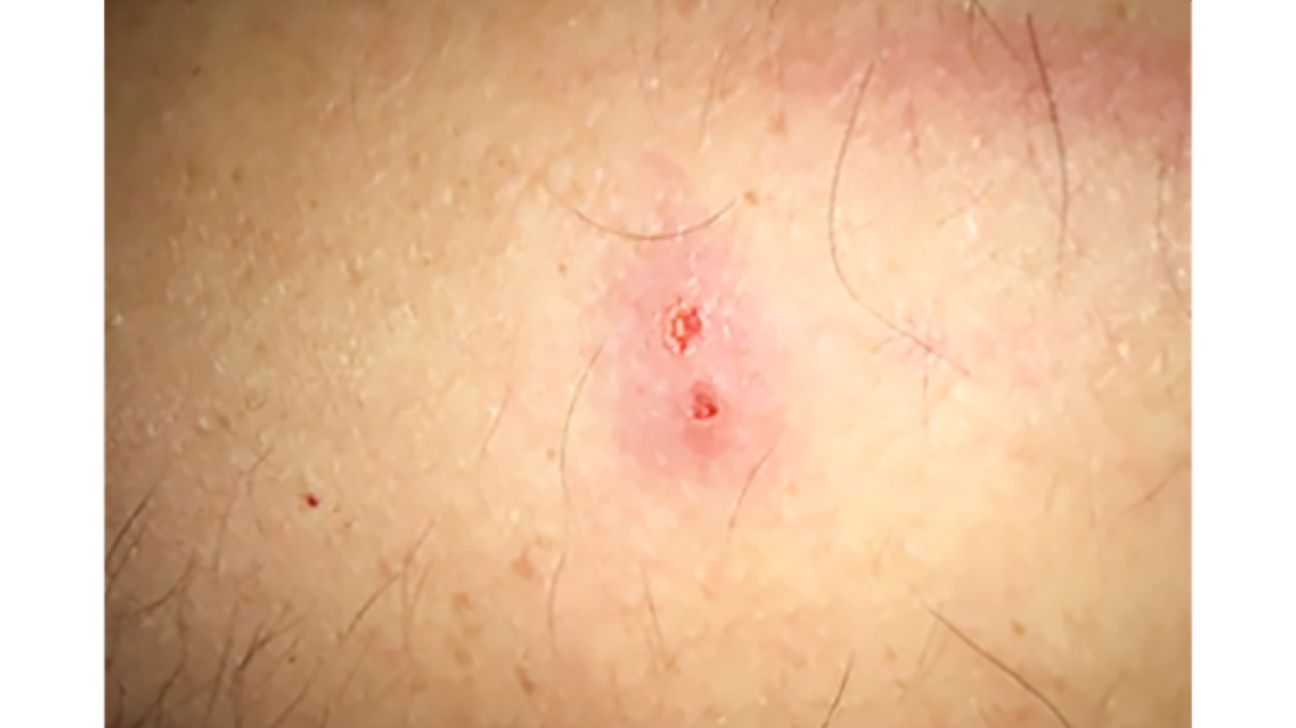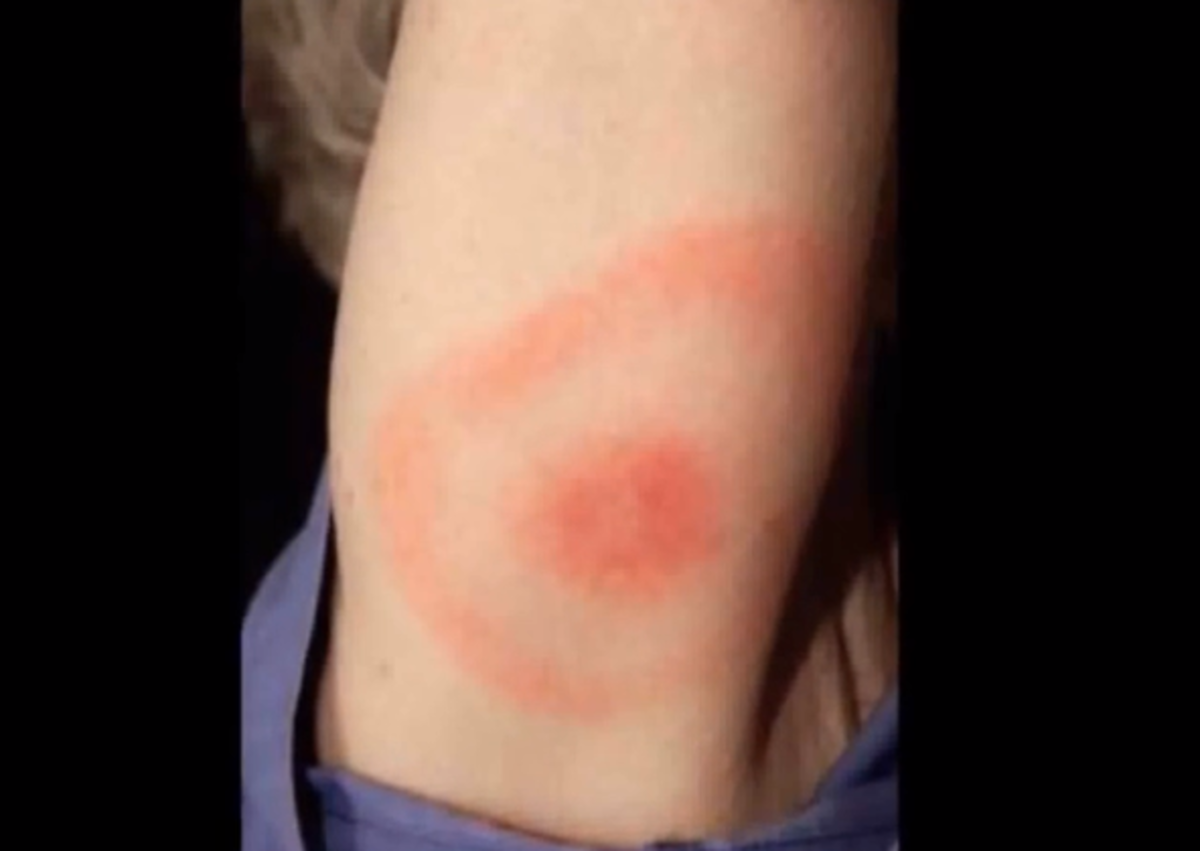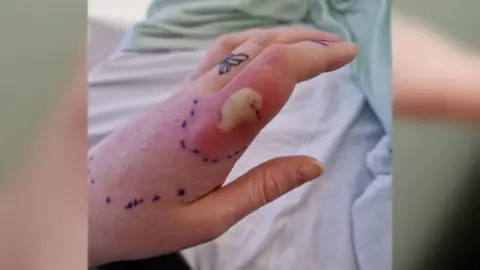Are you concerned about redback spider bites? These spiders are common in Australia and can be dangerous. Redback spider bite images are useful for identifying the signs quickly. This article will show you how to identify a bite and what to do next.
Continue reading to protect yourself from these sneaky spiders.
Key Takeaways
- Redback spider bites look like small red marks that can swell and hurt. The bite area may turn bright red or purple.
- Key signs of a bite include pain that spreads, sweating at the bite site, and goosebumps on the skin.
- For first aid, apply ice, take pain meds, clean the bite, and keep the area still. Don’t use pressure bandages.
- Seek medical help if pain gets worse or spreads. Call the Victorian Poisons Information Centre on 13 11 26 for advice.
- Prevent bites by checking dark spots, wearing gloves outside, and keeping your yard tidy. Redback spiders like dry, quiet areas.


Recognising Redback Spider Bites

Redback spider bites require prompt identification. These arachnids measure approximately 1 cm in length. They possess a black body with a red-orange stripe or spot on their back. Most incidents occur when individuals inadvertently contact the spider’s web.
Check for small marks on your skin where you experienced a sting. The affected area may redden and swell.
Identifying the spider assists with treatment. Redback spiders are found throughout Victoria, Australia. They prefer dark, secluded areas. If you observe a small black spider with red markings, it could be a redback.

Exercise caution, as cupboard spiders and brown house spiders have a similar appearance. Their bites produce comparable symptoms. Consequently, medical professionals treat them similarly to redback bites.
Key Symptoms of a Redback Spider Bite
After encountering a redback spider, understanding its bite symptoms is crucial. Pain is the primary indicator of a redback spider bite. It begins subtly but intensifies rapidly. The pain can extend to lymph nodes, arms, legs, abdomen, chest, or back.
It may persist for days. Infants who are bitten may cry continuously.
Additional symptoms include nausea, fatigue, and generalised soreness. You may experience a headache, nausea, or stiff neck muscles. Some individuals perspire excessively at the bite site.
The skin surrounding the bite may become red or develop goosebumps. Children often experience elevated blood pressure and irritability. In uncommon instances, men may have prolonged erections.
Muscle deterioration or cardiac issues can also occur, though infrequently.
Images of Redback Spider Bites
Redback spider bites often appear as small red marks. These marks can swell and become painful. The bite area may turn bright red or purple. You might see two small puncture marks where the spider’s fangs entered.
Some people develop a rash or sweating near the bite. Recognising these signs is crucial for seeking prompt medical attention.

Photos of redback spider bites can assist in identifying them. Search for clear, close-up images that clearly show the bite area. Quality pictures will highlight key features such as swelling, colour changes, and any visible puncture marks.
RedbackSpider.com provides a variety of useful images to help you identify these bites accurately and safely.
Immediate First Aid Steps
After spotting a redback spider bite, prompt action is essential. Here are the steps to take immediately for first aid:
- Apply an ice pack to the bite area. This reduces pain and swelling.
- Take pain relief medicine like paracetamol or ibuprofen. The correct dose is 15 mg/kg of paracetamol (max 1 g) or 10 mg/kg of ibuprofen (max 400 mg).
- Clean the bite site with soap and water. This prevents infection.
- Keep the bite area still and lower than the heart. This reduces venom spread.
- Remove any tight clothing or jewellery near the bite. Swelling may occur.
- Record the time of the bite and monitor for symptoms. This assists doctors in treatment.
- Do not use pressure bandages. They are ineffective for redback spider bites.
- Seek medical help if pain intensifies or spreads. Doctors may prescribe stronger pain medication like oxycodone.
- Remain calm and rest. Moving around can accelerate venom spread.
- Don’t attempt to catch the spider. Focus on getting help instead.

When to Seek Medical Attention
Obtain medical assistance promptly if you experience severe symptoms following a spider bite. Contact the Victorian Poisons Information Centre on 13 11 26 for immediate guidance. They operate 24/7.
If pain persists despite over-the-counter pain relief, consult a doctor. For children, ring the PIPER Service on 1300 137 650, a dedicated helpline for infants and young children.
Seek immediate care if symptoms worsen. Some individuals require specialised treatment such as antivenom. Only medical professionals can administer this after consulting with specialists to ensure its appropriateness.

It’s prudent to err on the side of caution. If uncertain, seek advice. The specialists at the poison centre can provide direction on the next steps to take.
Supplementary Information on Redback Spider Bites
This section provides additional information on redback spider bites. Continue reading to learn about bite misidentification, comparisons, prevention, and spider behaviour.
Common Misidentifications of Spider Bites
Spider bites are frequently confused with other insect bites or skin conditions. Many individuals mistake various bites for redback spider bites. Cupboard spiders and brown house spiders can produce symptoms similar to redback bites.
These spiders are part of the Steatoda family. White-tailed spiders are often wrongly accused of causing severe bites, but they typically only result in minor swelling and itching.
Skin ulcers are occasionally mistaken for spider bites. This condition is referred to as necrotising arachnidism. However, spiders do not cause this condition. The exact cause of these sores remains unknown to medical professionals.
Recognising the actual symptoms of a redback spider bite is essential for obtaining appropriate treatment. We will now examine the primary symptoms of a redback spider bite.
Comparison Table: Redback Spider Bites vs. Other Spider Bites
After discussing common misidentifications, we’ll compare redback spider bites to other spider bites. This table highlights key differences to help identify a redback bite.
| Feature | Redback Spider Bite | Other Spider Bites |
|---|---|---|
| Pain Location | Spreads to lymph nodes, limbs, abdomen, chest, or back | Often stays local to bite area |
| Fang Marks | Visible in about 5% of cases | More often visible |
| Local Sweating | Common at bite site | Rare |
| Piloerection (Goosebumps) | Often present | Uncommon |
| Erythema (Redness) | Usually present | May or may not be present |
This table shows clear signs of a redback spider bite. Pain that spreads, local sweating, and goosebumps are key clues. Fang marks aren’t always visible in redback bites. Other spider bites often cause less severe symptoms. If you notice these signs, seek help promptly. RedBackSpider.com provides additional information on bite identification and first aid.
Preventive Measures to Avoid Spider Bites
Keeping spiders away is essential to avoiding bites. Here are some tips to help you stay safe from redback spiders and other eight-legged creatures:
- Regularly inspect dark spots. Examine sheds, cubby houses, and under shelves for webs or spiders.
- Reduce clutter. Spiders prefer messy areas, so tidy up to make your space less appealing.
- Close off entry points. Fill gaps in doors, windows, and walls to prevent spiders from entering.
- Use gloves when working outside. This safeguards your hands when gardening or moving items.
- Check shoes and clothes. Spiders may hide in items left outside or unused for extended periods.
- Try natural deterrents. Peppermint oil or vinegar can assist in keeping spiders away from your home.
- Maintain a tidy yard. Trim bushes and clear leaf piles where spiders might reside.
- Fit screens on windows and doors. This helps prevent spiders and other insects from entering your house.
- Exercise caution in dry areas. Redback spiders prefer dry spots, so be careful in sheds and similar locations.
- Inform family members. Teach children and others how to recognise and avoid spider habitats.
Understanding the Redback Spider: Identification and Habits
After understanding how to prevent spider bites, it’s essential to learn about the redback spider. These spiders are small but pose a significant risk. They measure about 1 cm in size, making them difficult to spot.
Their most distinctive feature is a red-orange stripe or spot on their black abdomen. This mark aids in quick identification.
Redback spiders prefer dry, sheltered locations. They’re commonly found in cubby houses, sheds, and under shelves. They construct webs in these areas and await prey. Most bites occur when people accidentally contact the spider in its web.
Understanding the habitats of these spiders can enhance your safety. Always inspect dark corners and quiet areas before reaching in.
Funnel Web Spider: Navigating Redback Spider Bites and Other Dangerous Encounters
RedBackSpider.com reveals crucial tips on redback spider bites and how they compare to a funnel web spider or mouse spider situation. This post is worth reading because it outlines first aid steps, potential allergic reaction risks, and advice for different bites and stings.
1. What Is a Funnel-Web Spider?
A funnel-web spider is a venomous spider found throughout australia, known for a funnel-web spider bite that may become life-threatening if not treated. Unlike the red back or black spider, funnel-webs are large and aggressive.
2. Are Mouse Spiders Equally Dangerous?
Yes. A mouse spider is a venomous arachnid that can cause severe arachnidism in some cases. While not as common as huntsman spiders or a recluse spider, a bite from mouse spiders may still cause serious reactions.
3. When Does Anaphylaxis Occur?
Anaphylaxis happens if a person has a severe allergic reaction. Always call triple zero if symptoms worsen. This can involve the bitten limb swelling or respiratory issues.
4. What About a Funnel-Web Spider Bite?
A funnel-web spider bite can inject venom directly into tissue. If the bite is severe, immediate resuscitation measures are needed. Make sure to keep a finger between the bandage when wrapping, starting just above the fingers.
5. Is a Recluse Spider a Concern?
A recluse spider is less common in Australia. However, if encountered, spider bites can cause skin ulcers or necrotising arachnidism in rare instances.
6. Recognising Signs and Symptoms
Look for pain, swelling, or local sweating. Some venomous bites may start just above the fingers and spread. If so, seek medical attention immediately.
7. How to Handle a Dangerous Spider?
Dangerous spider species like red-back and other spider types or funnel-web and mouse spiders prefer dark areas. Never try to catch the spider unless safe.
Comparison Table: Common Spiders in Australia
| Spider | Venom Strength | Typical Habitat |
|---|---|---|
| Funnel-Web Spider | High (venomous) | Gardens, moist areas |
| Red Back Spider | Moderate-High | Sheds, dry crevices |
| Mouse Spider | Moderate-High | Bushland, logs |
| White-Tailed Spider | Mild-Moderate | Homes, under bark |
Key Points to Remember:
- Spiders in australia include funnel-web spider and red back spider.
- Venomous spider bites can trigger anaphylaxis in a severe allergic reaction.
- Call triple zero if breathing difficulty occurs.
- A bandage can help prevent the venom from spreading, but ensure you easily slide a finger under it.
Conclusion
Recognising redback spider bites is crucial for saving lives. Prompt action and appropriate first aid are essential. Always consult medical professionals if uncertain. Protect yourself by learning about these spiders and their behaviour.
With proper understanding, you can safeguard yourself and others from potential harm.
FAQs
1. What do redback spider bites look like?
Redback spider bites often show as small, red marks… They might be hard to spot at first. The area around the bite can swell up and get quite sore. In some cases, you might see two tiny puncture marks where the spider’s fangs went in.
2. How can I tell if I’ve been bitten by a redback spider?
Well, mate, the signs can be tricky. You might feel a sharp, burning pain at first. Then, the pain can spread and get worse over time. You could start sweating a lot, especially near the bite. Some folks feel sick in the guts or get a headache. If you notice these signs, it’s best to seek help quick smart.
3. What’s the first aid for a redback spider bite?
Right, here’s what you do: Stay calm, wash the bite area with soap and water. Put a cold pack on it to help with pain and swelling. Don’t try to catch the spider, but if you can, take a photo – it’ll help the docs. Most important, get to a hospital or call 000 if you’re feeling really crook.
4. Are redback spider bites deadly?
Look, redback bites can be nasty, but they’re rarely fatal these days. We’ve got good antivenom now. Still, they can make you pretty sick, especially kids and older folks. That’s why it’s crucial to get medical help if you think you’ve been bitten. Better safe than sorry, eh?





